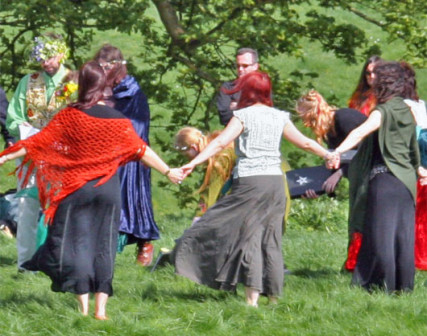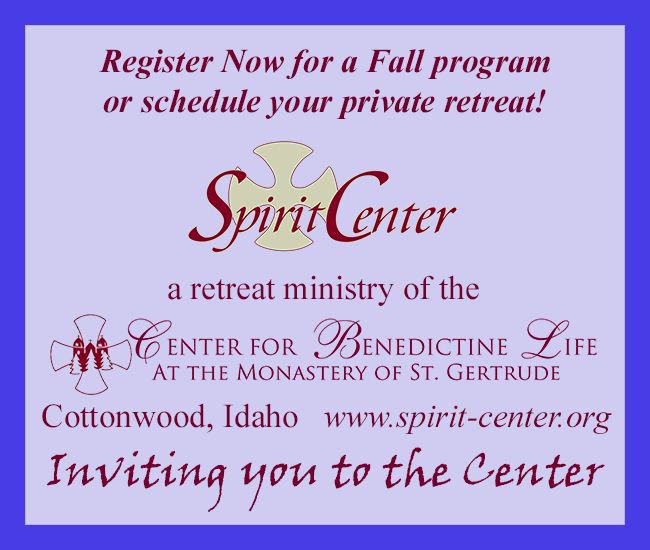
Recently, a friend said to me, “So-and-So would really like to come to one of our Full Moon Goddess gatherings but the word ritual makes her nervous. Maybe it would help if you could talk about what a ritual is and what it means.”
By definition a ritual is nothing more than a series of actions conducted in a particular order. A ritual can be as ceremonious and symbolic as the coronation of a king or as mundane as making a cup of coffee. What makes a ritual carry a sense of the sacred is the import we attach to it.
Joseph Campbell says, “Ritual is the enactment of a myth. By participating in a ritual you are participating in a myth.”
Whether or not we’re conscious of it, our lives are steeped in ritual. The way we get ready in the morning. The way we prepare our meditation or prayer space. The gathering of a team for a pep talk before the big game. Graduation ceremonies. Marriage. Funeral services. Singing the National Anthem. A parade. All hold ritualistic qualities that most of us ignore until we bump against the word in the context of religion and spirituality. Then, the word ritual becomes haunting and quickly associated with cults and witchcraft. Suddenly, we are not speaking about actions of reverence but of evil.
It’s too bad that our imaginations are conditioned in this way. What little I know about cults suggests a theme where individual development is traded for the unequivocal acceptance and guidance from a leading entity. Rituals are performed not to enhance personal growth but to surrender power and control. By definition this is not the enactment of a myth but the action of oppression.
With respect witchcraft, it is true that ritual is an integral part of every Wiccan ceremony but what stifles curiosity about Wiccan practices and by default women, is the collective imagination still governed by misinformation, fear, and hatred. As such, people have a hard time getting past ghoulish nonsense and stereotypes.
The point of participating in a ritual is not to make something special or magical happen. The purpose of a ritual is to remove one’s ego enough to be aware of the sacred that is everywhere.
I grew up Catholic and there isn’t anything about the Catholic Mass that isn’t ritualized. From the swinging of a smoldering incense holder in the four directions, to communion, to kneeling and saying the Lord’s prayer, to even my favorite part when we exchange peace with one another. Everything is done with purpose and scrutiny embodied in all kinds of symbols. The garments the priest wears, the chalices, and linens are precise in the story they are trying to convey.
The Catholic Ritual is a glorious enactment of the New Testament and certainly played a key role in my becoming a ritual writer in the pagan realm. Everything I do when I perform a ritual, whether it’s blessing the Spring garden, Honoring Abundance, Celebrating Winter Solstice, or Burning Banishment is done deliberately. Every word, movement, and tool is planned to play a specific symbolic role in the myth I am enacting.
For instance, soon I will gather with women to perform the ritual I call “Pinning Intentions.” The myth we are enacting is the story of promising resolutions in the New Year. The only historical evidence I have regarding people using the New Year as the time to pledge personal change comes from Wikipedia. Symbolically, it makes sense. We turn the calendar over and so we, too, can turn over ourselves. The New Year is the time to reflect on the lessons of the previous one and make changes accordingly. So, I wrote a ritual enacting that.
The first action in every ritual I write and perform is to create a circle. That is a ritual all by itself—an enactment of the Alpha and Omega. The Circle is the symbolic shape suggesting no beginning/no end, nothing above and nothing below. Equal energy going round and round and round. It reflects the infinite cycle of life and death.
Once everyone is comfortable in the circle we will be guided in meditation to create pause and help put our minds at ease. Next, we will listen to an astrology reading, which is always a highlight. The awareness of where the planets and stars are aligned in any given moment is an artform rarely celebrated and yet offers fascinating revelations. When I take a moment to remember the moon governs the tide, I am humbled by the vastness of the celestial world I do not know and can’t fathom. Then the four directions will be honored as well as the grounding center. I usually sing a song while tossing dried petals in each direction. The song is never the same with the words coming to me in that moment. At this point, we have created a sacred safe space.
Next, I will pass around a fabric scroll—a quilt like wall hanging that has been sewn (by me) using scraps of fabric to make a mural that represent this group of women. Every woman present has been asked to bring with them a single word written on a ribbon or a piece of fabric. This one word represents their focus and spiritual practice for the coming year. The scroll will be passed around so every woman will have a chance to hold it and their intention. When the scroll has been around the circle, I will open it and hold it while we take turns pinning on our intentions. The women can either tell the story behind the intention or pin it silently.
When the last intention as been pinned, this piece of art will have been infused with a collective soul acting as a visual reminder to what we aspire. What makes this ritual sacred is the courageous action of pinning a promise before everyone and speaking about what inspired that word. Each woman, in their vulnerability, abandons their ego to share with the group what their spiritual self seeks. That action alone is what makes this enactment so empowering.
We will close the circle with a prayer and then a bowing ritual I call, I See You.
I suppose some might say that this isn’t a real ritual. I mean seriously, given the variety of the Pagan community, someone is bound to be miffed that I don’t follow a certain form or don’t invoke a certain deity or stray from a generally agreed script. But I say, “Who cares? What difference does it make? All rituals are the invention of someone. Why not me? Why not you?”
The bottom line is that rituals are meant to raise awareness in your own mind. When you begin to see just how ritualized your life is then you can begin exercising greater awareness by asking, “Why do I do what I do? Why do I think what I think? How do I feel after participating in this? How do I feel if I don’t participate in this? What could I do differently to appease my mind? What is the symbolic representation of all that I do and believe?”
To my mind, rituals are akin to enacting poetry. They bring art and beauty into our lives in ways that enhance a sense of spiritual peace. I don’t think this particular ritual is too witchy especially since I haven’t brought out my spell-casting sword, which is something I’ll share with you another time. It’s really pretty and I made it myself!






